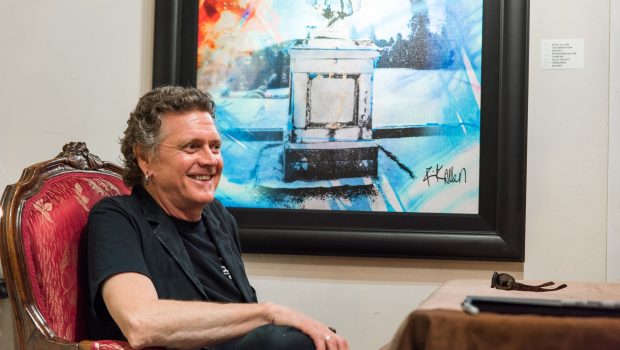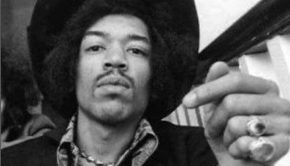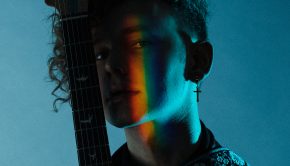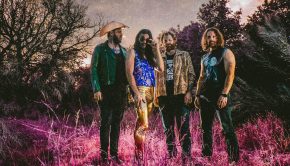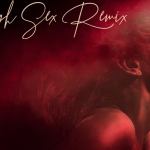Def Leppard’s Rick Allen On His On-Going Wentworth Gallery Exhibition In Pennsylvania
One of the bands most synonymous with the term “arena rock,” the music of Def Leppard has been heard in arenas and stadiums all over the world for the past 30-something years. The backbone of Def Leppard for all those years has been drummer Rick Allen. Currently, Allen and Def Leppard are on the road as part of a major North American co-headlining tour alongside Journey, which includes stops at Chicago’s Wrigley Field, Los Angeles’ The Forum, and New York’s Madison Square Garden.
Aside from his success with Def Leppard, Allen has also been successful as a painter. In the midst of the dates with Journey, Allen is presenting an art show titled The Art Of Rick Allen at the Wentworth Gallery in Philadelphia suburb King Of Prussia, PA. The show launched on May 12th and will continue through June 12th. Highlighted in this exhibit are Rick’s newest “Legend’s Series” portraits of Jimi Hendrix, John Lennon, and former Def Leppard bandmate Steve Clark. In addition, Allen’s show incorporates pieces from his “Art To Wear” jewelry line, hand-painted (and studio-used) bass and snare drums, and examples of his sculpting, altogether displaying more than 50 original works. The show will benefit the Project Resiliency organization — which provides programs that service U.S. Service Veterans and others in crisis — as founded by Allen and his wife, musician Lauren Monroe.
I had the pleasure of speaking with Rick Allen by phone, keeping the focus on his drum legend’s art career. More on Rick Allen can be found at www.rickallen.com, while more information on Allen’s on-going collaboration with the Wentworth Gallery is online at www.wentworth-art.com.
What exactly got you into doing the fine art that you do?
Rick Allen: I actually started painting when I was a kid. Sort of no training, nothing like that… I really enjoyed the medium, whatever it was I was doing. I just found it was a fantastic way for me to be in the moment. My mind would always wander, and I felt like painting was a great way to keep myself in the moment and in my heart, as opposed to allowing my mind to wander everywhere it wanted to. In many ways, music is very similar, but in reality, I discovered art, then I discovered music around the age of 10.
Really I came full circle when I started painting with my youngest daughter. I saw the way that she painted and it reminded me of myself. It reminded me of how I could lose myself in it with no rules, and literally just paint. I’d say to my daughter, “Is it finished?” She’d said, “Yeah, it’s done.” There was never any fear, and I loved seeing her do that. It really inspired me to want to paint again.
These days, I have a mentor, I have a few people that I’m really inspired by, particularly like Peter Max and his use of colors, then I like abstract like Salvador Dali, he’s been a really good influence. I’m on a voyage of discovery, just like I am with my music. I’m able to learn new things about myself as I move deeper into doing it. I think that’s the best way to learn, just to dive right in.
Something that’s very interesting to me about your art is the use of light or some sort of bright object. Where did that concept come from?
Rick Allen: Reality is very difficult to do, but it’s my attempt to painting the object or whatever it is. It’s a study of how the light bounces off of the object. Some of the more recent pieces, there was one that I did of Steve Clark, then there was one I did of John Lennon, I did one of Jimi Hendrix, the legends pieces. That to me was a study at how you’re really not painting the person’s face, you’re painting how the light bounces off of the person. If you look closely at some of the pieces, they make no sense when you look at them up close. When you stand back and you start to view it from a distance, it’s almost like your mind fills in the blanks and it creates the illusion of reality.
How did you make the journey from painting with your daughter to painting work that is sold through a gallery?
Rick Allen: I started working with a company called SceneFour, and that was using light sticks. It was almost like painting with light and then using long exposure photography, which was fun. But then I met up with a gallery called Wentworth Gallery. Christian O’Mahony, he encouraged me to start painting and actually using brushes on canvas and using acrylic paints. I just realized that I had a talent for it. I don’t know if you feel the same, you do what you want, you’re obviously able to do something with it, which is why you do what you do, but creativity is somewhat interchangeable.
I’ve always been into photography and it keeps me in the moment, it keeps me creative, it keeps me doing that I think is healthy. At the same time, I could take that creativity and put that into music or I could put that creativity into painting or writing or anything I set my mind to. I think the only that stops us as human beings, especially as we get a little older, is the fear of what other people are going to think about it, or their reactions to it. I found that there was a lot of fear surrounding the idea of a “rock star” going into painting. My wife said, “No, it’s great I love what you’re doing, and I think other people are going to like it too.” Once I got over that fear and I allowed other people to see my work, the response I got was really positive. That’s kind of what kept me going and is why I continue to do it to this day.
A big difference between your two career paths is that with your music, the goal is to sell many copies of it, and that more copies of it can always be made. With your painting, unless you do prints, only one copy can be produced and sold. Is it ever painful to sell your art and part with it?
Rick Allen: Yes, very. You start out with a blank canvas and then you start to do rough sketches and studies. You fall in love with the thing as you see it develop. Then by the time you’re a couple of weeks in, to me it’s really painful to let it go. I’d love to have some of these pieces on my wall, but unfortunately that’s the nature of what I do.
You mentioned Wentworth and they also work with Paul Stanley from KISS and Ric Ocasek from The Cars. Are there other musicians that you talk shop with when it comes to art?
Rick Allen: Paul, we went on tour with them in 2015 and that was a nice opportunity to ask him about his relationship with Wentworth. There’s quite a few musicians out there that are really quite talented. Any opportunity I get to talk to other people about their process and how they get to the finished result is always fun. It’s kind of like talking about recording. Everyone has their own idea of how to get to the finished thing. I think that’s part of the magic, figuring out how to do that. It’s always fun to talk to other people about the process.

